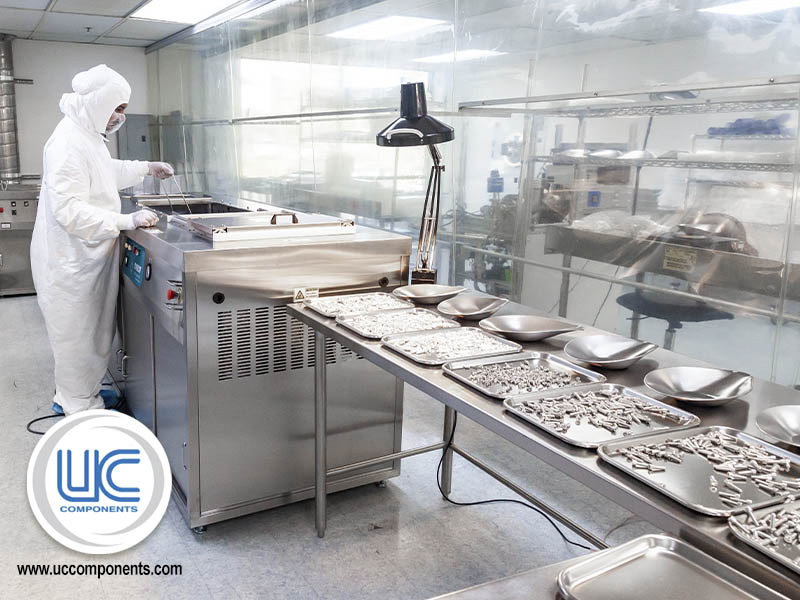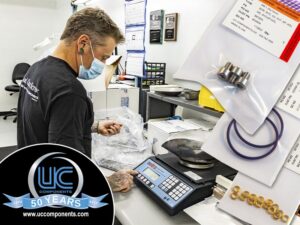Vacuum chambers must remain clean and free of contaminants and volatile materials that would lead to contamination of the entire system. Assembly for critical applications requires a wide variety of fasteners and their effectiveness is the key to the machine’s overall ability to function as intended. The materials used in their creation and post-fabrication treatments are vital, particularly if the fasteners will be exposed to corrosive elements, extreme temperatures, extreme pressure, or high levels of physical strain. We recently posted an article that went over the issues and contamination problems O-rings can cause within a vacuum system that hurts or inhibits its proper function. Did you know that similar problems can occur when using improper fasteners?
What type of contamination issues are we talking about? Issues such as:
- Imbedded and surface water
- Surface particulate
- Volatile organics
- Hydrocarbons
- And more
All of these cause virtual leaks, outgassing, and other catastrophic issues within a sealed vacuum system.
What are the sources of vacuum contamination from fasteners?
Fasteners can cause a variety of contamination issues due to:
- The materials they were made from
- Secondary treatments
- Not being properly cleaned
- Being touched by bare hands after proper cleaning
- Not being packaged correctly
- Utilizing the wrong type of fastener in a blind tapped hole
- And more
As you can see, surface contamination in a vacuum system can come from a wide variety of sources; all beginning with the original metal the fasteners were created from. This includes any wire or lubricants added to the surface, machining, tooling for drawing, rolling, and heading. The material that the fasteners are manufactured from, or coated with, can also potentially release light-weight molecules that can interfere with the vacuum process; even materials that are not normally considered absorbent (such as metals and glass). Mild steel parts are often chrome plated or black oxide coated to prevent rusting. These types of rust or corrosion-preventing methods should be carefully vetted for their appropriateness for vacuum service. Particles are another, more direct form of surface contamination and should be a factor in the choosing of type and coating and the users particular process specifications. Plastics, elastomers, porous metals or ceramics, and lubricants are some of the worst sources of material outgassing. Vapor pressure and the rate of chemical reactions at higher temperatures can also cause outgassing.
Hydrocarbon based lubricants can be a major source of contamination and are difficult to remove. Secondary hydrocarbon based lubricants (such as oils and grease) can be major and destructive forms of contamination in vacuum systems since they have very low vapor pressure and will spread throughout a tool quickly, requiring both lengthy and costly cleaning to fully remove.
Packaging of all types can impart contamination on the parts within as well. Proper packaging, including low-outgassing, particulate rated and/or static resistant is an additional consideration that must be taken into account.
Even handling a properly cleaned part with your bare hands can impart skin oils that will also outgas and drag your system down, emphasizing the need for gloved hands, and proper handling of a cleaned fastener.
How can these problems be solved?
A majority of these issues can be solved through the use of Vented Screws (also known as Vacuum Screws, Ventilation Screws, or Hollow Screws) and/or by vacuum baking. The rest of the issues come down to careful selection of fastener materials and platings, coupled with proper cleaning, packaging, and handling of the fastener after cleaning.
How does a vented screw help?
A vented screw features a hollow core and are specially designed to allow the release of gases, contaminants, and pressure through the fastener. Vented Screws are widely used within vacuum systems and enable faster, more efficient pump-down of HV, UHV, and EUV systems. These components allow the quick evacuation of trapped pockets of air and surface contaminants from blind-tapped holes.
How does vacuum baking help?
Vacuum Baking provides the ultimate level of contamination control for fasteners in very critical process environments. The vacuum baking cycle can be monitored and certified with a Residual Gas Analyzer (RGA) that can provide specific partial pressure peaks and insure a contaminate free product. Utilizing the proper fastener, cleaning technique will ultimately provide the best product for your vacuum system.
How can fasteners from UC Components, Inc. help you?
UC Components, Inc. has been the world leader in high vacuum hardware since 1974. Our vented fasteners provide a clean, clear path for trapped air and surface contaminants (such as water) to be pumped away from blind-tapped holes. This enables faster, more efficient pump-down of HV, UHV, and EUV systems, eliminates virtual leaks, and potential contaminants found in these voids. Installing UC’s RediVac® vented screws promotes greater system throughput and improved yield.
We also offer cleaned and vacuum baked O-rings plus a variety of standard hex nuts, washers, and screws to accompany the vented fastener line, along with custom product development, and Class 100/ISO Class 5 Cleanroom cleaning & packaging.
View our parts catalog online to find the components you need, request a quote, or contact us for more assistance or additional information. If you do not see the items that you need listed in our standard products, please give us a call! We may not stock it but we are happy to acquire and manufacture just about any fastener or O-ring that you need.



